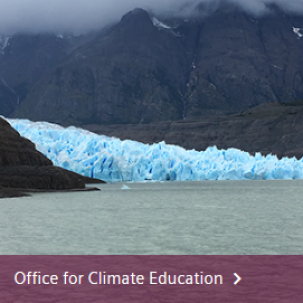News | Education | 27 July 2022
Innovative Global Action on STEM Education to Drive Sustainable Transformation
Earth Overshoot Day (28.07.2022) is marked at the point when human consumption outstrips the resources nature can regenerate in a year. With more than 5 months still to go in 2022, we are already in an ecological deficit. This calls for urgent action on all fronts, including education. As students rally around the world asking to “unite behind the science”, climate change has brought science, technology, engineering and math (STEM) subjects to the fore amongst the younger generation. At Siemens Stiftung, we have been at the helm of climate change education in STEM areas, driving a sustainable transformation with diverse offerings alongside our robust international network.
Children and young people need access to high-quality climate education, particularly those living in developing regions as they are more vulnerable to the extremities of climate change. While increasingly national curricula include climate change education, STEM teachers face the challenge of integrating current scientific findings into their lessons and often lack access to sophisticated teaching tools and relevant information. With our local cooperation partners, we develop and publish free Open Educational Resources (OER) in English, Spanish, French and German for schools worldwide. Teachers use them to disseminate knowledge on climate protection measures, and support students for individual and societal climate resilience.
One such example Mapa Interactivo del Cambio Climático (MICA), developed together with CIDSTEM, Pontificia Universidad Católica de Valparaíso (PUC) is an interactive learning kit with printable maps supported by a smartphone app with texts, images, videos, audio files, 3D objects, and links to regional information about climate change. These materials can be deployed both in classroom and remote learning situations. Students living in ecologically susceptible areas in Brazil, Chile, Colombia, Mexico and Peru use it to observe and document facts and learn through active participation about the impacts of climate change in their regions. Such learnings are not only applicable in Latin America or Africa, but we also aim to bring best practices to Europe and address pressing issues like water scarcity and fires.
Our priority is to deliver on the Sustainable Development Goals on education and climate action. We work together with climate scientists, educators and policymakers, facilitating dialogues and exchanges to integrate high-quality STEM education on climate change into national agendas.
On Earth Overshoot Day, we have compiled an outline of the latest teaching and innovative learning materials on climate change:
New: Media Package Climate Change – Part 1 “Understanding Global Warming”
The media package “Climate Change – Understanding Global Warming” is the first part of a multi-part series on climate change available on Siemens Stiftung’s media portal. The media package contains 19 individual media resources, covering topics like “Natural Greenhouse Effect”, “Anthropogenic Greenhouse Effect” and “Greenhouse Gases” that can be used in classrooms across all subjects. It aims to increase awareness among teachers and students by demonstrating solutions. It is based on materials developed by the Office for Climate Education (OCE). Currently, published in German: Media Package Climate Change, it will be available in English and Spanish.
New: Teacher’s Guide “Climate Change and Land” from the OCE
Together with OCE, we work with international foundations, NGOs and research institutes to produce free climate education teaching materials that can be used worldwide. All OCE materials are based on the reports of the Intergovernmental Panel on Climate Change (IPCC), whose findings are broken down into adaptable and easy-to-understand lessons. “Climate Change and Land” is the second thematic teacher’s guide, it is multidisciplinary and meant for elementary and middle school teachers (targeting students aged 9 to 15). It offers pre-designed lessons on climate change, suggestions on climate change mitigation and adaptation. Teacher’s Guide “Climate Change and Land” is available in English, French and Spanish.
Update: New teaching materials from our Latin American media platform CREA and STEM Initiatives for Sustainable Development and Climate Change Education
With Red STEM Latinoamérica, we provide a free education portal CREA (Centro de Recursos Educativos Abiertos) in Spanish which has 1,500 educational resources for STEM teaching. New materials are published here frequently, including on climate change education, such as the interactive climate change maps MICA and the “Crisis y Acción Climática” Experimento Blended project.
With project partners in Chile, Colombia, Ecuador, Argentina, Mexico, Peru and Brazil, we joined forces to adapt analog teaching materials and methods for digital implementation in STEM lessons in response to the challenges thrown by the pandemic. The results of this initiative and video clips will be shared shortly on Red STEM Lationamérica.
Together with the foundation Haus der Kleinen Forscher, we lead an international network “International Dialogue on STEM Education“(IDoS), connecting education experts from all over the world. In 2019, IDoS adopted the position paper “Using Science to Do Social Good: STEM Education for Sustainable Development”. The “IDoS Peers”, who are experts in the field of early STEM Education for Sustainable Development will meet on October 10-11 in Berlin to take further steps in this direction.
Get an overview of all our activities and initiatives on Climate Change Education
Related Links
New: Teacher's Guide "Climate Change and the Land" from the OCE
Together with OCE, we work with international foundations, NGOs and research institutes to produce free climate education teaching materials that can be used worldwide. All OCE materials are based on the reports of the Intergovernmental Panel on Climate Change (IPCC), whose findings are broken down into adaptable and easy-to-understand lessons. “Climate Change and the Land” is the second thematic teacher’s guide, it is multidisciplinary and meant for elementary and middle school teachers (targeting students aged 9 to 15). It offers pre-designed lessons on climate change, suggestions on climate change mitigation and adaptation. Teacher’s Guide “Climate Change and Land” is available in English, French and Spanish.



